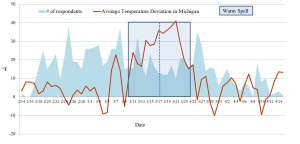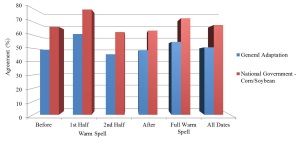
Feeding the planet under climate change and the uncertainty about future impacts on agricultural production is a compelling policy issue. Interpreting public opinion is critical for effective policy formulation and decision making. Most climate change public opinion surveys focus on generic issues such as belief in climate change or concern about its overall impacts (Capstick et al., 2015), instead of issues specific to particular economic sectors, such as agriculture. The generic belief, awareness, or concern related to climate change may not be a comprehensive predictor of the support for adaptation policies, as support may vary across subpopulations (Scheraga and Grambsch, 1998). Instead, understanding public opinions about potential areas for investments in adaptation can be more informative.
Prior work on opinions toward policies for agricultural adaptation is mostly from the viewpoint of policy makers or farmers (Kurukulasuriya and Rosenthal, 2013) rather than from that of the general public. The general public’s welfare change might not be in the same direction as that of farmers, who could directly benefit from certain adaptation policies. One critical way in which climate change would impact the general public is if the food supply is greatly reduced. Furthermore, agriculture has spillover effects on the local economy (Hornbeck and Keskin, 2015), so climate impacts on agriculture could be passed to the local community. Adaptation policies for the agriculture sector might thus be closely related to the local community’s welfare. Furthermore, as climate change is projected to affect regions differently, the direction and magnitude of agricultural productivity effects may vary by place.
Because of its diverse agriculture, the state of Michigan is a useful location for exploring the opinions of residents toward government involvement in helping local farmers adapt to climate change. Over 300 commodities are produced on a commercial basis (MDARD, 2013). Therefore, we can explore differences, if any, in attitudes in terms of crop types: staples, represented by corn and soybeans, and non-staples, represented by fruits and vegetables.

Source: NCDC (2013) and IPPSR’s (2015)
61st State of the State Survey.
Michigan State University’s Institute for Public Policy and Social Research (IPPSR) 61st State of the State Survey (SOSS) included questions regarding attitudes about government involvement in adaptation (IPPSR, 2015). One question measured attitudes toward government intervention for adaptation without specifying the industry. The other four questions gauged how attitudes may vary across two government levels, state or national, and two crop types, corn-soybeans compared to fruit-vegetables. Furthermore, since the telephone survey was conducted over a three-month period, during which a warm spell occurred, an opportunity was provided to examine public attitudes before, during, and after a temporary weather anomaly. Figure 1 displays the temperature fluctuations during this period and the number of responses with respect to the timing of the warm spell.
Public attitudes regarding government involvement were found to differ for general and agricultural adaptation (Figure 2). They also differed through sub-periods that varied with respect to an extreme temperature event. Figure 2 provides the frequencies with regard to national government assistance for corn/soybean farmers. The proportion of respondents strongly and somewhat agreeing to the statement about general adaptation is lower than that for the statement regarding agricultural adaptation. Results for state intervention and fruit/vegetable farmers were similar (Lee, 2015); thus, the Michigan public supports both state and federal involvement in assistance to various types of farms.

Source: IPPSR’s (2015) 61st State of the State
Survey.
In our survey, the relationship between attitudes about climate change and socio-economic variables is similar to the findings in the literature, such as opposition from white males documented by McCright and Dunlap (2011), but we also find public attitudes were affected by temperature in a complex way.
Respondents' attitudes at different points before, during, and after the warm spell varied (Figure 2). Residents showed the highest support for farmer adaptation during the early part of the warm spell when residents were more likely to agree to the idea of government support for adaptation than those who responded during the pre-warm-spell period. For the policy of national government assistance for corn/soybean farmers, the former is 73% and the latter is 66%. In the second half of the warm spell the proportion of agreement dropped to a level lower than that before the warm spell. After the warm spell, the support rates bounced back somewhat but were still lower than the pre-event level. Thus, the effects seem not to be a simple continuous relationship across the range of temperature abnormality. Rather, the influence of short term temperature shocks on public attitudes toward adaptation is more complicated than generally expected.
Advanced statistical models confirmed that the stage of the warm spell had a significant influence on public attitudes (Lee, 2015). While the positive effect of the first half of the warm spell is what one might expect, as most other studies suggested, explanations for the reduction of public agreement in the later stage are less clear. Explanations for these public views could be due to respondents adjusting to the abnormality; media coverage waning during the second half of the warm spell; temperatures, although still much above normal, declining during the latter part of the warm spell compared to the rising temperatures in the first half; or, finally, that the continuing warm spell, which produced unusually pleasant but unseasonal temperatures, challenged residents pre-survey attitudes about climate change.
A large majority of Michigan residents support government action in assisting farmers to adapt to climate change, especially compared to the more modest support for adaptation intervention when the sector of the economy was not specified. Information from opinion polls that do not provide details on the sectors to be targeted may not reveal sufficient, robust information to policy makers who are initiating plans for a specific industry to cope with climate change. Clearly there may be limits to this finding, and the general public may not distinguish among detailed variations of adaptation policies even while they have different attitudes toward specific industries such as agriculture. Nonetheless, gauging public opinions about climate change issues requires sophisticated public opinion polls that take into account different economic sectors.
As public attitudes toward climate change adaptation can be affected by short run temperature, the interpretation of responses to public opinion polls that were conducted within a small temporal window should be interpreted cautiously. Our findings about the complex effect of short-term temperature variations on public support for government intervention for agricultural adaptation may also apply to other areas likely to be influenced by climate change such as the government's role in protecting citizens from human health consequences of climate change. Any climate change policy that is informed by public opinion polling must verify if responses are conditioned on recent or concurrent temperature variations and whether short term spikes in opinion hold up in the long run. Furthermore, additional research is needed on the role of short-term temperature variations on public opinion regarding climate change. The effects of contemporaneous weather on public opinion regarding adaptation may evolve over time if the general public becomes more able to differentiate between unseasonal climate variation and long-term climate change.
Finally, as the stronger support to agriculture adaptation reveals different perceptions in the public’s minds, policy makers as well as other interest groups should consider agriculture separately when designing climate change policies. A one-size-fits all approach to gauging whether a policy will be accepted may slow the progress of adaptation, leading to reduced long-run productivity of the agricultural sector.
Capstick, S., L. Whitmarsh, W. Poortinga, N. Pidgeon, and P. Upham. 2015. "International Trends in Public Perceptions of Climate Change over the Past Quarter Century." Wiley Interdisciplinary Reviews: Climate Change 6 (1): 35-61.
Hornbeck, R., and P. Keskin. 2015. "Does Agriculture Generate Local Economic Spillovers? Short-Run and Long-Run Evidence from the Ogallala Aquifer." American Economic Journal: Economic Policy 7 (2): 192-213.
Institute for Public Policy and Social Research (IPPSR). 2015. State of the State Survey. Available online: http://ippsr.msu.edu/soss/
Kurukulasuriya, P., and S. Rosenthal. 2013. "Climate Change and Agriculture: A Review of Impacts and Adaptations." Washington, DC. World Bank.
Lee, G.E. 2015. “Essays in State-Level Climate Change Policies.” PhD Dissertation, Michigan State University, East Lansing.
McCright, A.M., and R.E. Dunlap. 2011. "Cool Dudes: The Denial of Climate Change among Conservative White Males in the United States." Global Environmental Change 21 (4): 1163-1172.
Michigan Department of Agriculture and Rural Development (MDARD). 2013. Michigan Agricultural Snapshot. Available online: http://www.michigan.gov/documents/mdard/MDARD_Ag_Snapshot_1-10-2013-_FINAL_2_408019_7.pdf?20131226150022
National Climatic Data Center (NCDC). 2013. Quality Controlled Local Climatological Data. Available online: http://www.ncdc.noaa.gov/data-access/land-based-station-data/land-based-datasets/quality-controlled-local-climatological-data-qclcd
Scheraga, J.D., and A.E. Grambsch. 1998. "Risks, Opportunities, and Adaptation to Climate Change." Climate Research 11 (1): 85-95.